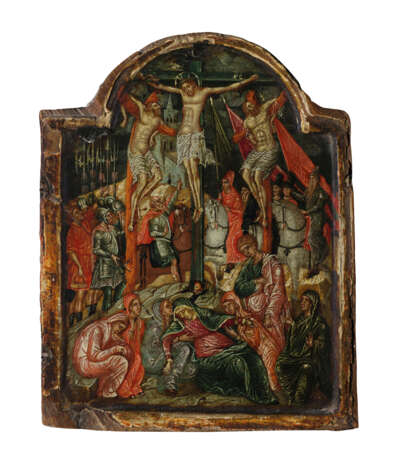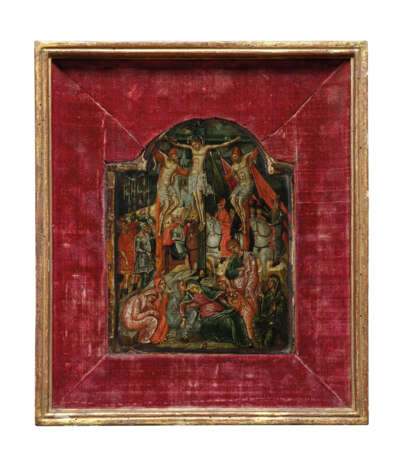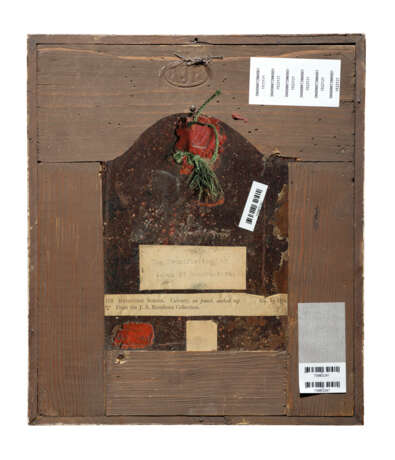ID 1071560
Lot 1 | ATTRIBUÉ À GEÓRGIOS KLÓNTZAS (1530-1608)
Estimate value
€ 15 000 – 20 000
La Crucifixion
tempera et huile sur panneau, cintré dans la partie supérieure
dans un cadre intégral
16,5 x 13 cm. (6 ½ x 5 1⁄8 in.)
Provenance
Johann Anton Ramboux (1790-1866) ; sa vente, Lempertz, Cologne, (Me Heberle), 23 mai 1867, lot 284 (comme 'Imitation neo-grecque. Revers d'un triptyque: le Crucifiement du Christ').
Collection particulière, Belgique.
Further Details
ATTRIBUTED TO GEÓRGIOS KLÓNTZAS, THE CRUCIFIXION, TEMPERA AND OIL ON PANEL, ARCHED-TOP, IN AN INTEGRAL FRAME
George Klontzas (circa 1535-1608) belonged to the Cretan school of painting. This was deeply influenced by Venetian trends from the 15th to 17th centuries, as the island belonged to the Venetian Republic until the Ottoman invasion of 1645. This period, known as the 'Cretan Renaissance', saw the Byzantine motifs and iconographic codes of the Orthodox Church mixed with those originating in the Serenissima; associated in the 16th century with the figures of Titian (1488/1490-1576), Tintoretto (1518-1594) and Veronese (1528-1588).
In this jewel-like painting, Klontzas treats the Crucifixion, an iconographic subject dear to both the Orthodox and Roman Churches, in the manner of an icon, its small format implying that it was an object of private devotion. This post-Byzantine heritage is combined with motifs from Venetian painting, such as the horsemen and their mounts, and the bell tower in the background – all reminiscent of the Crucifixion by Vivarini (active around 1415-1480) in the Art Museum of Ravenna. Our Crucifixion can also be compared with that of another painter who left his mark on the Cretan Renaissance, Georgios Markazinis (active in the 17th century), which also features a cityscape in the background (Istituto Ellenico di Studi Bizantini e Postbizantini di Venezia, Venice).
The treatment of the drapery, with its accentuated folds, and of the figures in the foreground - including the Virgin and Saint John - recalls that of El Greco (1541-1614) in his icon of the Dormition of the Virgin (fig. 1), still in its eponymous church in Ermoúpoli. This is not surprising, as the two painters definitely knew one another; in 1564, Klontzas was hired by El Greco to estimate an icon (M. Constantoudaki, 'Klontzas, Georgios c. 1535-1608', in G. Speak, Encyclopedia of Greece and the Hellenic Tradition, Abingdon-on-Thames, 2021, II, p. 893).
The provenance of this small panel is also worth noting, as it appeared in the posthumous sale of Johann Anton Ramboux (1790-1866), who, as the catalogue of his sale states, was the 'Curator of the Cologne City Museum' at the end of his career. Born in Trier, Prussia, he quickly discovered a talent for drawing that enabled him to join the Paris studio of Jacques-Louis David (1748-1825) in 1812. On the strength of this training, he entered the Academy of Fine Arts in Munich in 1815 before moving to Rome the following year. In the Eternal City, he frequented the Nazarene milieu. This first Italian sojourn (1816-1822) left its mark on Ramboux, who returned to live there a decade later. Here he painted in all genres - religious scenes, genre scenes and landscapes, as well as making a number of copies of Renaissance works. The Museum Kunstpalast in Düsseldorf has an interesting copy by Ramboux of Saint Francis of Assisi Receiving the Stigmata by Giotto (1267-1337) (inv. no. R50). His appointment to Cologne in 1844 as head of the collection of Ferdinand Franz Wallraf (1748-1824) – now the Wallraf Richartz Museum – eventually led him to return to Prussia. Ramboux's career perfectly exemplifies the 'connoisseur-artist' so highly revered in the Nineteenth Century.
| Artist: | Georgios Klontzas (1535 - 1608) |
|---|---|
| Applied technique: | Oil on panel |
| Art style: | Old Masters |
| Place of origin: | Greece, Europe |
| Auction house category: | Paintings |
| Artist: | Georgios Klontzas (1535 - 1608) |
|---|---|
| Applied technique: | Oil on panel |
| Art style: | Old Masters |
| Place of origin: | Greece, Europe |
| Auction house category: | Paintings |
| Address of auction |
CHRISTIE'S 9 Avenue Matignon 75008 Paris France | ||||||||||||||
|---|---|---|---|---|---|---|---|---|---|---|---|---|---|---|---|
| Preview |
| ||||||||||||||
| Phone | +33 (0)1 40 76 85 85 | ||||||||||||||
| Fax | +33 (0)1 40 76 85 86 | ||||||||||||||
| Conditions of purchase | Conditions of purchase | ||||||||||||||
| Shipping |
Postal service Courier service pickup by yourself | ||||||||||||||
| Payment methods |
Wire Transfer | ||||||||||||||
| Business hours | Business hours
|





